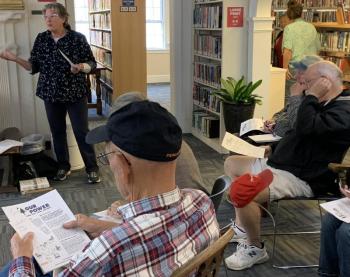Pine Tree Power makes pitch for consumer-owned utility
Southport resident Climo Smith was one of nearly two dozen attendees Oct. 13 at a Pine Tree Power informational session in Boothbay Harbor, and he asked the question on everybody’s mind. “How will ratepayers pay for the estimated $13.5 billion in acquiring Central Maine Power’s and Versant Power’s assets in transforming into a consumer-owned utility?”
In November, voters will be answering a slightly different question, Maine Referendum Question No. 3: “Do you want to create a new power company governed by an elected board to acquire and operate existing for-profit electricity transmission and distribution facilities in Maine?” Jill Linzee of Bristol is on the Pine Tree Power board of directors. She led the 75-minute informational session held at Boothbay Harbor Memorial Library. She described CMP’s and Versant Power’s estimated cost as inflated and inaccurate.
“It’s outrageous (and) not based on fact,” she said. “Utilities each year must report a Net Book Value. The grid, poles, wires, equipment and everything else. Last year, they reported their value at $5 billion which is far below $13.5 billion. There will be a negotiated price, but it won’t be three times the current value.”
Linzee also explained how she became involved in Pine Tree Power. In 2019, she was chairman of the Climate Action Group of Maine Unitarian Universalist State Advocacy Network. The group was interested in climate policy and began tracking a bill working its way through the Maine Legislature. She also serves on the Our Power Executive Committee. For the past 18 months, she has worked to educate people about the Pine Tree Power initiative.
In a nutshell, the proposal would replace Maine’s two for-profit utilities with a nonprofit. Maine has 10 other power utilities which are consumer-owned nonprofits. Linzee reported CMP and Versant combined accrued $187 million in profits, and consistently rated poor on overall customer satisfactory surveys. She added that both corporations are foreign-owned. CMP is a subsidiary of Avangrid and Iberdola is the parent company of Avangrid, which is Spanish. Versant is owned by the City of Calgary, Alberta. Conversely, Lindsey believes a consumer-owned nonprofit would re-invest the $187 million back into improving the grid and customer service.
As a nonprofit, Linzee said Pine Tree Power has advantages over for-profit entities. As a nonprofit, Pine Tree Power could borrow money at a rate as low as 3% compared to for-profit operations which borrow at 8-10%.
“Maine’s consumer-owned utilities all deliver power at a cheaper rate and provide better customer service. The grid will need significant upgrading in the near future, and this can be done cheaper by a nonprofit such as Pine Tree Power,” she said. “Maine economist Richard Silkman, a Republican, supports Pine Tree. He said the lower interest rates would save ratepayers $9 billion over 30 years.”
As a for-profit utility, CMP and Versant are allowed to earn a profit between 8-14%, according to Linzee. She pointed to sharp increases in her bill in recent months as another reason for switching to Pine Tree Power.
Linzee outlined how the new utility would be managed. For-profit and consumer-owned utilities are governed by state law. The governor, legislature, public advocate and Maine Public Utilities Commission all have a role in monitoring their behavior. This would not change, except the charter granting CMP and Versant permission to operate as a monopoly would be revoked. “CMP and Versant were granted a monopoly by the State of Maine. The people have a right to revoke that privilege if they find the utilities unfit to serve, charge too high rates, provide unreliable service along with too many billing hassles,” she said.
A 13-person board of directors would operate the consumer-owned utility. Seven would be elected and six non-voting members would form the board. The seven elected members would appoint experts in the utility industry as non-voting board members. The seven voting districts would be modeled after Maine’s state senate districts. Five of the seven would be south of Augusta. The Boothbay Register asked why each Maine county would not have a voting member as part of the board. She did not have an answer and directed the question to former State Rep. Seth Berry, D-Bowdoinham, who participated in writing the bill.
“We were advised that the only certain constitutional way was to use equally proportioned districts. This is the only way every person gets an equal say,” he wrote. “As for the expert members, we wanted to be sure we included talent on the board from individuals who may be less willing to put their name on a ballot, but who have meaningful expertise to offer. This is the advantage of all appointed positions. The disadvantage is that appointees are not as directly accountable. So we felt a balance was best.”
Linzee reported each director would receive between $100 and $150 per meeting. She believes this is a better method than how CMP compensates its board members. “Former Governor John Baldacci is a CMP director. He receives $200,000 per year, as do all of their directors,” she said.
The consumer-owned board of directors would hire a private company to manage the utility. Linzee reported the legislation bars CMP or Versant from bidding on the project.
A major rational in Pine Tree Power’s existence is providing better customer service. The Boothbay Register asked why the Maine PUC had not done more to bring these two utilities in line with their mission. Linzee replied, politics. “It takes corporate money to run for statewide office. That’s regardless of whether you're a Republican, Independent or Democrat.” The Boothbay Register asked why such popular and highly respected governors like Baldacci, Angus King and Janet Mills had not appointed like-minded commissioners. “That’s a good question,” she said.
Returning to Climo’s question, Linzee responded, “Lower interest rates, keeping profits in-state and reinvesting them into the grid would make purchasing the two privately owned utilities and making long-term improvements feasible.”
Question 3 appears on the Nov. 7 statewide referendum ballot.































